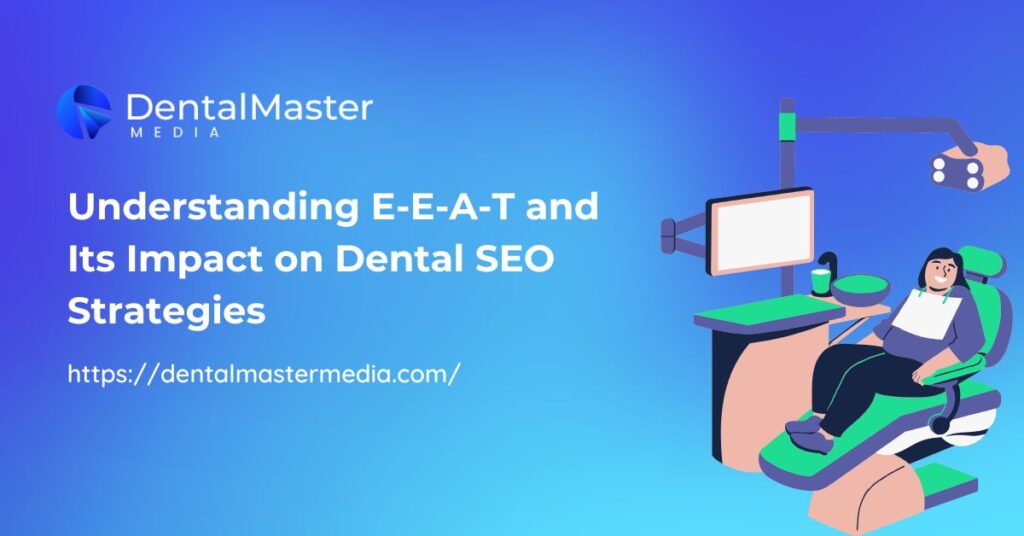In today’s digital-first world, dentists must go beyond traditional marketing strategies to attract and retain patients. One of the most powerful tools at their disposal is search engine optimization (SEO).
However, SEO is not just about keywords and backlinks anymore. Google’s algorithm has evolved significantly, with a major emphasis on content quality and credibility.
A core component of this shift is a concept known as E-E-A-T — Experience, Expertise, Authoritativeness, and Trustworthiness.
In this article, we’ll explore what E-E-A-T means, how it impacts your dental website’s visibility, and how you can leverage it to boost your practice’s online presence. Whether you’re a new dentist looking to establish a digital footprint or an established practitioner aiming to stay competitive, understanding E-E-A-T is crucial for a successful dental SEO strategy.
What Is E-E-A-T?
E-E-A-T stands for:
Experience: Does the content reflect real-world, hands-on experience?
Expertise: Is the content created by a subject-matter expert?
Authoritativeness: Is the source a recognized leader or authority in the field?
Trustworthiness: Is the website and content safe, honest, and transparent?
E-E-A-T is not a direct ranking factor but is part of Google’s Search Quality Evaluator Guidelines. These guidelines help human reviewers assess the quality of Google’s search results and influence how the algorithm is trained. A reputable dental SEO company can help ensure your website aligns with E-E-A-T principles, increasing the chances of performing well in search rankings.
Why E-E-A-T Matters for Dental SEO
Dental services fall under a category Google refers to as “Your Money or Your Life” (YMYL) content. This means that your content can significantly impact someone’s health, financial stability, or well-being. Google holds YMYL pages to a higher standard, requiring them to demonstrate a high level of E-E-A-T.
For dentists, this means your website must clearly convey that you’re a licensed professional with the right qualifications and a trustworthy reputation. Without establishing E-E-A-T, even a beautifully designed website may struggle to rank well.
Let’s break down how each element of E-E-A-T applies to dental SEO strategies.
1. Experience
Incorporating personal experience into your content adds authenticity. Patients want to know that you’ve actually performed certain procedures and can speak from hands-on involvement.
How to demonstrate experience:
- Share patient case studies (with consent).
- Include photos or videos of your team at work.
- Write blog posts based on real-life experiences in your practice.
- Discuss common patient concerns and how you address them.
Adding a personal touch not only builds trust but also sets your content apart from generic articles.
2. Expertise
Search engines want to serve up content that is accurate and written by people who know what they’re talking about. For dentists, this means demonstrating your clinical knowledge in a clear, digestible way.
Ways to establish expertise:
- Write educational content about dental procedures, conditions, and treatments.
- Ensure your content is authored or reviewed by a licensed dentist.
- Highlight your credentials and ongoing education.
- Create an “About the Author” section for blog posts.
Google wants to see that the person giving dental advice is qualified to do so. Featuring your credentials on each page builds your credibility.
3. Authoritativeness
Being an authority means others look to you as a reliable source of information. In the dental world, this could mean getting cited by reputable websites, being featured in interviews, or receiving online reviews from happy patients.
Build authority through:
- Guest posting on reputable dental or medical blogs.
- Being listed in professional directories.
- Participating in community outreach or dental health seminars.
- Getting backlinks from high-authority websites.
Social proof also helps. The more positive buzz you generate online, the more authoritative your practice appears to both Google and potential patients.
4. Trustworthiness
Trust is arguably the most critical component of E-E-A-T, especially for healthcare-related content. Patients are handing over not just their money but also their health. They need to feel safe and secure, and Google wants to reward websites that offer a trustworthy experience.
Ways to build trust:
- Display your physical address and contact information clearly.
- Use HTTPS (secure website protocol).
- Feature honest patient testimonials and reviews.
- Maintain an updated privacy policy and terms of service.
- Avoid misleading claims or exaggerated outcomes.
A secure, transparent, and user-friendly website will rank better and convert more visitors into patients.
How E-E-A-T Impacts Local Dental SEO
Local SEO is a huge part of digital marketing for dentists. After all, most people are looking for dental services near them. E-E-A-T significantly affects local rankings because Google wants to show the best, most trustworthy results in local map packs and search results.
Google Business Profile (GBP) Optimization
Your Google Business Profile should be fully optimized and up-to-date. Include:
- High-quality photos of your practice
- Verified business hours
- Patient reviews and responses
- Correct NAP (Name, Address, Phone Number)
Keeping this information current shows that your practice is active and engaged — two important trust signals.

Online Reviews
Positive reviews boost both your authority and trustworthiness. Encourage satisfied patients to leave reviews on Google and other platforms. Respond to reviews — both positive and negative — to demonstrate engagement and professionalism.
Local Content Strategy
Develop content that speaks directly to your local audience. Blog about community events, share local oral health tips, or feature nearby dental news. These topics not only engage readers but also help you appear more relevant to search engines.
Creating Content That Aligns with E-E-A-T
Content remains king in Dental SEO, but it must be high quality to make an impact. Here are a few strategies to create content that aligns with E-E-A-T and resonates with your audience.
Focus on Patient Education
Educational content is one of the best ways to demonstrate expertise. Write about common dental procedures, prevention tips, or frequently asked questions. The goal is to provide clear, accurate, and helpful information that builds trust.
Use Structured Data
Implementing schema markup (structured data) on your website helps search engines understand who you are and what services you offer. Dental-specific schema types can improve your visibility in local search and even earn you rich snippets in results.
Refresh Old Content
Google favors up-to-date information. Periodically review and update older content to reflect the latest techniques, technologies, or service offerings in your practice. Add new insights or experiences to show ongoing expertise.
Build a Content Plan
Plan out your content calendar to ensure consistency. Post blogs, videos, FAQs, and service pages regularly. Use patient questions as inspiration — if one person is asking, chances are others are too.
Technical SEO and E-E-A-T
Even if your content is top-tier, a poor technical SEO setup can undermine your E-E-A-T efforts. Here’s how to align your website infrastructure with E-E-A-T principles:
- Mobile optimization: Most dental searches happen on mobile devices. Your site must be responsive.
- Fast load times: A slow website hurts user experience and can reduce trust.
- Clear navigation: Make it easy for visitors to find what they need.
- Secure browsing: Always use HTTPS.
- Clean URLs: Keep them short and descriptive.
These elements improve usability, a key factor in both Dental SEO guide and trustworthiness.
Measuring the Success of Your E-E-A-T Strategy
Once you implement E-E-A-T-driven strategies, it’s important to track your progress to understand what’s working and where improvements are needed.
Use tools like Google Analytics, Google Search Console, and rank tracking software to monitor key performance indicators. Pay close attention to your organic traffic growth, keyword rankings (especially for local search terms), average time on page, and bounce rates.
These metrics can reveal how engaging and relevant your content is. Most importantly, track your conversions — such as appointment requests and form submissions — to measure the real-world impact of your SEO efforts.
If your content is truly valuable and aligned with E-E-A-T, you should see gradual improvements in both website traffic and patient inquiries.
Conclusion:
As competition among dental practices increases, having a strong online presence is no longer optional — it’s essential. Embracing E-E-A-T principles helps your website not only perform better in search results but also build lasting trust with potential patients.
When your content is rooted in real-world experience, written with expertise, supported by authority, and radiates trustworthiness, you create a digital presence that stands out. Implementing these strategies doesn’t just help your SEO; it strengthens your overall brand.
If you’re just starting your digital journey or trying to elevate your existing presence, consider focusing on bold SEO strategies like E-E-A-T, because content alone won’t cut it anymore. Now more than ever, patients want to know that they can rely on you — both in the chair and online.
In summary, bold strategies in SEO for Dentists are grounded in more than just keywords and links. By aligning with E-E-A-T principles, you’re positioning your dental practice for long-term success in a highly competitive digital space.
And remember, SEO for Dentists isn’t just about rankings — it’s about reputation, relationships, and results.

Suraj Rana is the owner of Dental Master Media and a leading expert in SEO for dental practices. With a passion for dental marketing, he has successfully helped numerous dental clinics climb the search engine ranks. Suraj’s expertise makes him a go-to resource for effective, results-driven dental marketing.

